Original URL: https://www.theregister.com/2014/03/04/review_motorola_moto_x_android_smartphone/
X-rated Android antics: Motorola's Moto X puts boot in chunky brother
G biz! Does X mark the spot?
Posted in Personal Tech, 4th March 2014 13:24 GMT
Review When the Moto X was launched in the US back in August, it was a pretty big deal. Why? Because it was the first handset wholly conceived by Motorola under Google's stewardship, it was assembled in the States itself rather than the Far East, it was available with a dizzying number of personalisation options thanks to the Moto Maker website ... and at $330 it offered good value too.
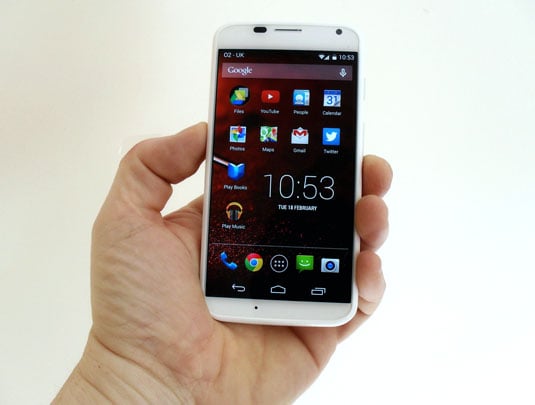
Motorola's Moto X adds refinements over its chunky budget brother, the Moto G
But what a difference six months and a trip across the Atlantic makes. Motorola has now been flogged to Chinese OEM Lenovo, its CEO has jumped ship to DropBox, Moto Maker remains a US-only option, while the "locally assembled" tag is rendered meaningless. Furthermore, the arrival of the Moto G has redefined what an affordable 'droid can be. Indeed, on the latter point, it begs the question if there's space left in the UK phone market for the Moto X at all?
Despite having a larger screen at 4.7 inches rather than the Moto G's 4.5-inch display, the Moto X is a noticeably smaller and lighter device. The differences may not appear much at all – 13g lighter, 1.2mm thinner, 0.6mm narrower and shorter – but it surely does add up. It's not just a case of the Moto X being unusually petite in this era of huge 5-inch überphones, but also that the Moto G is a bit of a lump by comparison.
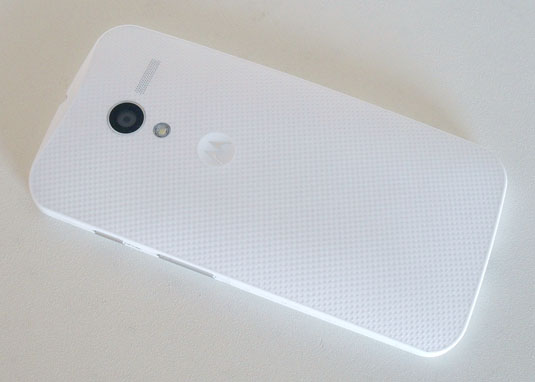
The back looks dimpled but is actually smooth
The Moto G’s apparent bulk in no way detracts from the fact that the Moto X is a supremely ergonomic handset. I’ve seldom held a mobile that feels so natural in the hand: the curvaceous rear - which looks dimpled but is in fact wholly smooth - the gently curved and impressively minimal screen side bezel and the overall size, combine to make the Moto X very easy to hold and use. It’s a solid bit of kit too, helped here by the fixed battery.
We may as well get this out of the way now: as well as lacking a user replaceable battery the Moto X doesn’t have a memory card slot though since it comes in 16GB and 32GB flavours, rather than the Moto G’s 8GB and 16B capacities, this is perhaps not such a handicap.
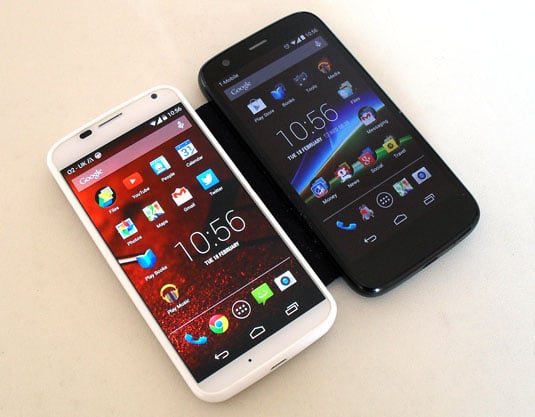
Side-by-side: Moto X (left) has larger screen, smaller body compared to the Moto G (right)
Like the Moto G, the Moto X has a 720 x 1280 display. Spread over a 4.7-inch panel that results in a pixels-per-inch density of 312 compared to the G’s 326ppi. Yet put the numbers to one side and you'll discover there's no visible difference in sharpness. I suspect that, like Apple, Motorola has decided that the headlong gallop towards ever higher screen resolutions on sub 5-inch mobile phones is just a little pointless, unless you have the eyesight of a kestrel.
The big difference between the X and the G is in the screen tech. The X uses a RGB-matrix AMOLED panel to the G’s IPS LCD. This means it is more vivid, shows blacker blacks and is easier to read in direct sunlight. The downside is that it lacks the natural hues you get with a good LCD panel.
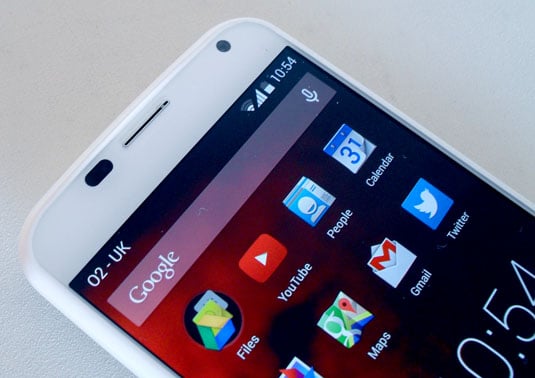
Equipped with 2Mp forward facing webcam
Like the display, the Moto X’s chipset is also a different way to skin a cat. In place of the Moto G’s Qualcomm MSM8226 1.2GHz quad-core component there is a 1.7Ghz dual-core Qualcomm MSM8960Pro Krait chip with 2 rather than 1GB of RAM and an Adreno 320 rather than 305 GPU.
In terms of AnTuTu benchmark scores, the Moto X comfortably outscores the Moto G, turning in results of around 22,500 to the cheaper device's 17,200. The same was true for the SunSpider browser test in Chrome. In the real world though, there is little, if any, discernable difference in performance.
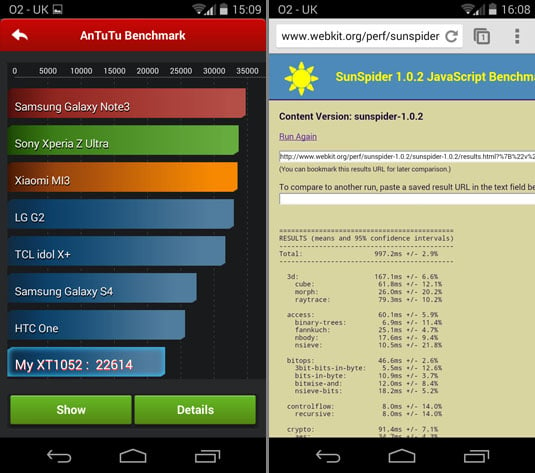
Motorola Moto X AnTuTu and SunSpider scores
Where the Moto X’s chipset does return a real dividend is in battery life. The Moto X has a larger battery than the Moto G – 2200mAh compared to 2070mAh – which accounts for some of the difference but not all, I suspect. Looping a 720p MP4 video drained the Moto X in 9.5 hours, a whole 90 minutes better than the Moto G managed. A full charge of either handset should get you through a solid 48 hours of medium-to-heavy use.
Invisible touch
One of the more interesting bits of hardware in the Motorola Moto X is its 10Mp camera sensor, which uses of what Motorola calls ClearPixel technology. In plain English, the sensor’s 1.4 micron pixels rather than a RGBG matrix use an RGBC (C for clear) arrangement which apparently can capture up to 75 per cent more light.
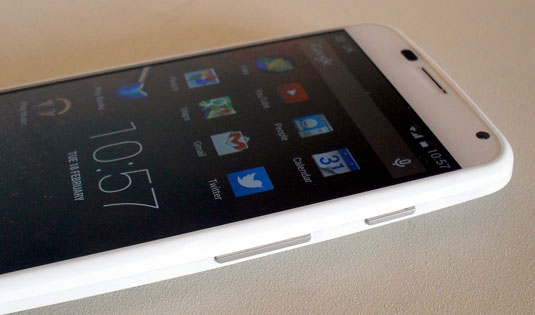
Volume and power controls in familar places
The end result is that the Moto X’s camera is a country mile better than the Moto G’s in any circumstances, though in low light this 10Mp snapper won't worry Lumia 1020 owners. As for the Moto G's 5MP offering, this is the one place where the budget asking price becomes entirely obvious.
Dig into the Moto X's camera settings and you’ll find an option to launch the app by giving the handset a quick double-twist with your wrist. That sounds not a little peculiar but, once you get used to the action, it’s a surprisingly quick and easy way to fire the camera up. It’s not a feature I recall coming across on a mobile phone before which, on reflection, I find surprising.
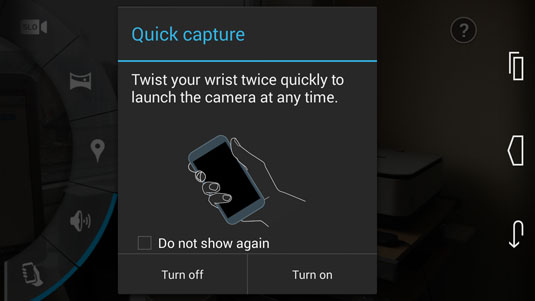
Wrist controlled shooting, anyone?
Other technical advantages that may nudge you towards the Moto X include dual-band 802.11n Wi-Fi, an NFC chip and the presence of a 4G radio (remember, the Moto G has to make do with 3G). The 2Mp webcam is also a step up from the G’s rather mediocre 1.3MP affair and the single speaker is less sibilant and delivers a punchier bottom end.
The Moto X also has a few software advantages over the G. The Big Idea is what Motorola calls Touchless Control which lets you launch Google Now by simply saying “OK Google Now”. Even from standby. Once launched it works as Google Now always has done but the ability to just yell at your phone in any circumstances and get a reply is extraordinarily useful. It’s the first time I’ve found myself regularly using voice command on any phone, iOS or Android.
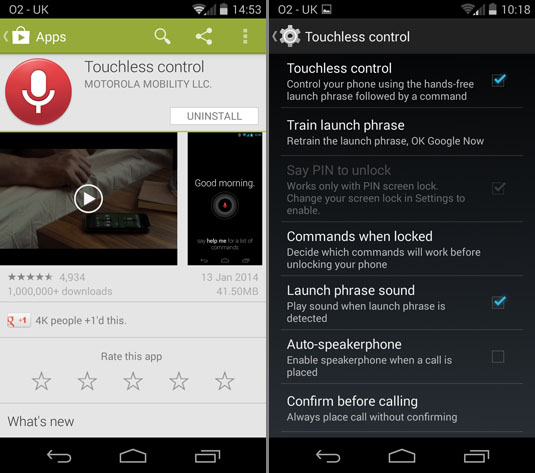
The Moto X Touchless app is hardware specific – you won't find this running on the budget Moto G
The Touchless Control requires a specific low core speed processor that allows the phone to be constantly listening out for you without draining the battery. So don’t think you can simply side-load a hacked APK onto your Moto G, as this is a hardware-specific feature. Incidentally, voice call quality and signal reception were both spot on during my test.
Other features which Motorola has added to the Android mix include Active Display and Connect. The former shows various phone notifications – SMS messages, Gmail, missed calls and suchlike – on the lock screen when you take the phone out of your pocket or bag. You can tap the icons to go straight to the related apps. It’s a peripheral but not un-useful little feature.
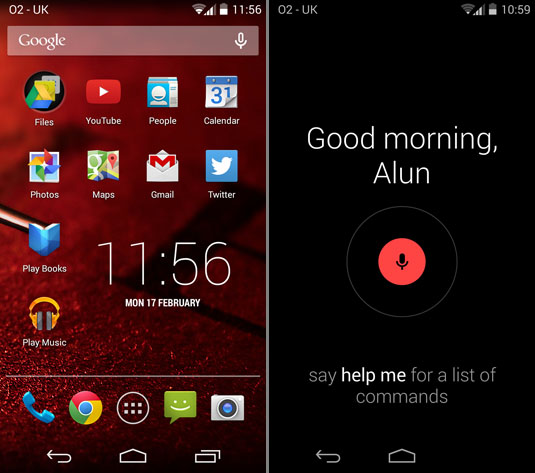
Close to stock Android and Google Now voice commands
Connect, meanwhile, allows you to read and reply to texts, and see who’s calling you from your Chrome browser. Still, that’s nothing you can’t also do with the Moto G using any one of a number of third party apps.
British Moto X handsets are arriving with Android 4.4.2 KitKat installed out-of-the-box. Since reviewing the Moto G I’ve received several emails from El Reg readers complaining that their Moto Gs don’t play nice with KitKat although I have to say my own Moto G has worked faultlessly since the update. So maybe the X is a safer option if you want a bang up-to-date incarnation of Android.
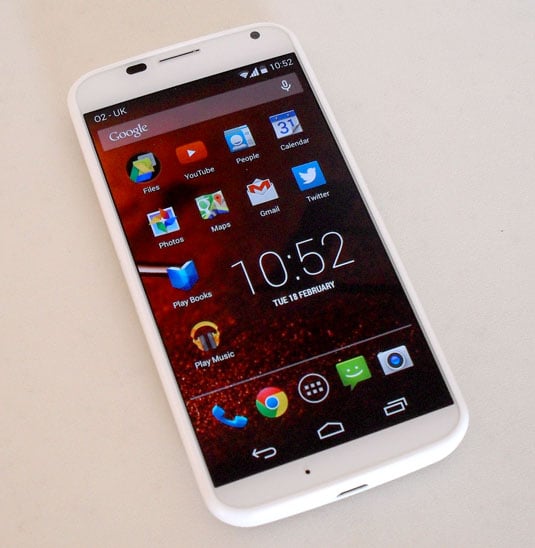
It took its time getting here, just a shame about the US/UK price differences
Before I wrap up I have to say that I think Motorola has missed a trick by not letting European customers access the Moto Maker facility. Sure it would take a few extra days to ship the handsets across the Atlantic, but I’d happily pay a few extra quid and wait a week to have my Moto X with a wooden back panel and my name engraved on it. The price could be a bit more aggressive too. After all, $330 vs £300 is a poor exchange even allowing for VAT.
The Reg Verdict
So, is the Moto X worth the extra cash over a Moto G? If you are buying SIM-free or PAYG and don’t have or want a 4G service, then arguably not. The Moto G is such idiotically good value such that it beats every other mobile on the market hollow, if you are paying upfront. But if you are buying on contract and the difference is a fiver or less a month then it’s not such a clear-cut choice.
The Moto X is smaller and lighter, supports 4G, has more storage, better battery life, a much better camera and a larger screen. It’s also a genuine delight from an ergonomic point of view. The voice command system is a feature you quickly grow to appreciate and I say that as a man who thinks voice command is vastly overrated as a concept.
Would I pay an extra £5 a month for an X over a G? I think I would. And don’t overlook the fact that even at £300 SIM-free, the Moto X is still £170 cheaper than an Apple iPhone 5c. ®